In my recent article “My Love Of Jetties, Some Of My Jetty Work, Granite Island Jetties & A List Of S.A. Jetties Built During the 1800s Or Early 1900s” I wrote about the Granite Island Causeway and the Victoria Pier there at Victor Harbor.
Some of those details included:
“The August 2011 newsletter also included my article titled “My Recent Visit to the SA Maritime Museum”. The newsletter included this old photo of the Granite Island causeway: –
Causeway, jetty & public baths, Victor Harbor
(I had taken a photo of the photograph at the Maritime Museum during my visit there. The same photo features on page 189 of “The Jetties of South Australia – Past and Present” by Neville Collins. It is said to have been taken about 1911. It was provided by the Victor Harbor branch of the National Trust of South Australia.)
According to my article, “It was taken from the island, looking back towards the mainland. It shows the old Victoria Pier (with public baths) in the background.”
“The first part of the causeway to Granite Island at Victor Harbor was built between 1862 and 1864. It was Victor’s first jetty. A pier was built at the end of this jetty. It was named the Victoria Pier after Queen Victoria and it was opened on 4th August 1864, following the opening of the extension of the railway from Port Elliot to Victor Harbor on the same day. Swimming baths were constructed on either side of the jetty (causeway) because men and women had to bathe separately. A deeper swimming area was then built between the jetty and its spur (the Victoria Pier) in 1899. A larger area had to be made for swimming by 1905. The baths had a shark-proof fence built around them. The baths, however, fell into such a bad state of disrepair that they were not being used and were eventually demolished in 1955.”
According to “The Jetties of South Australia – Past and Present” by Neville Collins, the pier was “facing an easterly direction for a length of 542m”. There is no mention of the swimming baths in the book though.
According to the “Holiday at Victor Harbor” web page, “Bathing facilities – a shed built at Encounter Bay in 1874 was eventually replaced by “bathing houses” on the beach each side of the town jetty. This led to “The Baths” being built, enclosing part of the sea off the jetty, for more serious swimmers. By 1905 The Baths were so popular that more accommodation was added, with dressing rooms, charging three pence for admission. A kiosk opened on Granite Island in 1910. The Baths were demolished in 1955 after storm damage.”
I now want to describe the pier and baths in more detail. The two postcards, provided by courtesy of Allan Horsfall, of the Working Jetty in “My Love of Jetties, Some of My Jetty Work, Granite Island Jetties & A List Of S.A. Jetties Built During the 1800s Or Early 1900s”, showed the Victoria Pier in background. Here are two more postcards from Allan Horsfall, both showing the Victoria Pier much closer: –
The Victoria Pier
(Postcard courtesy of Allan Horsfall)
The Victoria Pier
(Postcard courtesy of Allan Horsfall)
(One interesting point about this black & white postcard is the old building in the right-hand foreground. One possibility is that the building is a blacksmith’s shop and sleeping accommodation erected by a Mr Wishart in July 1872)
I like this photo showing the causeway and pier: –
Causeway and pier
(Source: http://shawfactor.com/gazetteer/south-australia/victor-harbor/ )
I found some more photos (‘slides’) of the Granite Island causeway and Victoria Pier. ‘Slide 1’ is at
http://www.victorharbortimes.com.au/story/3209176/archival-revival-victor-harbor-photos/#slide=1 . Slides 2 & 3 follow on. The photos came from the State Library of South Australia, which allowed me to share the photos on my Facebook page. Slide 1 shows the Granite Island causeway and Victoria Pier in 1950. Slide 2 shows the Granite Island causeway and Victoria Pier in 1930 and Slide 3 shows the Granite Island causeway and Victoria Pier in 1910.
According to “The Victor Harbor Story” by AA Strempel & JC Tolley, “Mr W.Hanson, Colonial Architect and Inspector of Railways, was sent to Victor Harbor to report on the jetty required for the handling of cargo. . . . After receipt of Hanson’s report, the necessary authority to formally establish Victor Harbor as the port for the Murray Trade was obtained from Parliament and on 25th June, 1862, a contract was let to Mt Gouge for £8,600 for the construction of a Jetty and Pier. The work commenced the following month . . .”
When some problems were encountered, “Gouge declared himself insolvent” and work was delayed. “Operations were resumed in November, 1863, under the direction of . . . Gouge’s original foreman. During the early part of 1864 . . . the piling being carried out to the full distance by the end of June. In addition to the work included in the original contract, a shed capable of holding eight loaded trucks was erected at the end of the jetty for the protection of goods awaiting shipment.”
An opening ceremony was held “on 4th August, 1864, after the railway extension (From Port Elliot to Victor) had been officially opened.” A band led a procession of people along the jetty. “A bag of wheat was lowered into a boat as the first installment of cargo to be shipped from the jetty. Mr Dodson, the Chairman of the Encounter Bay District Council, then stepped forward and declared the jetty open for public traffic under the name of the Victoria pier (sic).” There were three cheers “for the Queen and the Royal Family and the band struck up the National Anthem. At night a dinner was held at the Victor Harbor Hotel where about 60 guests sat down to a table . . . . This was followed by a ball.” A dinner was held for the railway and jetty contractors at the Port Elliot Hotel the following evening.
The ‘contemporary’ press of the day described the Victoria Pier as “entirely constructed of colonial Gum. The pier consists of 89 bays each 20 ft. long, making a total length of 1,780 ft. Each bay is supported by 3 piles at each end with the exception of the head which for 7 bays has 5 piles and for 3 bays 7 piles in each tier. The outside piles are 12” by 12” and about 20 ft. long and the centre ones 14” by 14” by about the same length (20 ft.?). The erection of the pier took nearly two years and cost about £8,800. The railway continues up to the end of the jetty where cranes are to be placed for loading and unloading cargo.”
When the full causeway to Granite Island was ultimately completed in 1875, the goods shed on the Victoria Pier was moved to the island.
Of the swimming baths at the pier, my article “My Love Of Jetties, Some Of My Jetty Work, Granite Island Jetties & A List Of S.A. Jetties Built During the 1800s Or Early 1900s” stated firstly, “Swimming baths were constructed on either side of the jetty (causeway) because men and women had to bathe separately.”
That statement was followed by, “A deeper swimming area was then built between the jetty and its spur (the Victoria Pier) in 1899.”
The next statement stated, “A larger area had to be made for swimming by 1905. The baths had a shark-proof fence built around them. The baths, however, fell into such a bad state of disrepair that they were not being used and were eventually demolished in 1955.”
Allan Horsfall has also provided this postcard of the larger area of the swimming baths built in 1905: –
Swimming baths at the Victoria Pier (prior to March 1912)
(Postcard courtesy of Allan Horsfall)
The above postcard image is the best (only) one that I have been able to find to date. The Flinders University 2007 Maritime Archaeology Field School attempted a survey of the swimming baths area in February 2007 – see: –
http://mua.apps.uri.edu/project_journals/flinders/flinders_intro.shtml ,
http://mua.apps.uri.edu/project_journals/flinders/f2-6.shtml, http://mua.apps.uri.edu/project_journals/flinders/f2-7.shtml and http://mua.apps.uri.edu/project_journals/flinders/f2-7b.shtml (and to a lesser degree, http://mua.apps.uri.edu/project_journals/flinders/f2-13.shtml ).
Divers from the Flinders University 2007 Maritime
Archaeology Field School gearing up
(Source: http://mua.apps.uri.edu/project_journals/flinders/f2-7.shtml )
Agnes Milowka, David Kalinowski & David M. VanZandt from the Flinders University 2007 Maritime Archaeology Field School wrote a report titled “Pre-disturbance Survey of the Historic Granite Island Causeway and Baths”. Manuscripts are on file at Flinders University.
The following postcard image features the Granite Island end of the causeway. It is referred to as “The Family Corner” and it seems that this location was popular with families for paddling or wading around the rocks in the water.
The Family Corner, Granite Island
(Postcard courtesy of Allan Horsfall)
Just for comparison, this is how the Family Corner looked from the other direction in about 1911: –
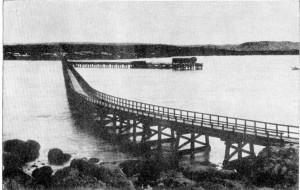
Causeway with the Family Corner in foreground
(I had taken a photo of the photograph at the Maritime Museum during my visit there. The same photo features on page 189 of “The Jetties of South Australia – Past and Present” by Neville Collins. It is said to have been taken about 1911. It was provided by the Victor Harbor branch of the National Trust of South Australia.)
Meron Peake provided us with this photo of the baths (from her Facebook page): –
The famous swim baths Granite Island, Victor Harbor, operating from about 1899.
The Baths were demolished in 1955 after storm damage.”
(Photo courtesy of Meron Peake. Source: https://www.facebook.com/photo.php?fbid=597993407248049&set=a.114958865551508.1073741827.100011121848916&type=3&theater )
Many thanks Meron.

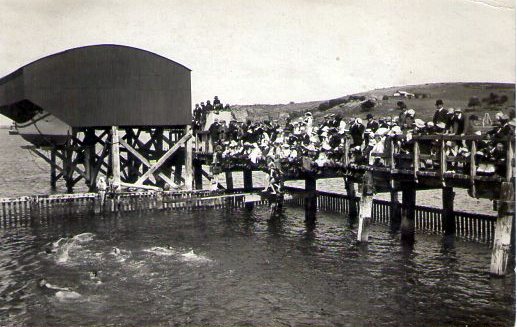
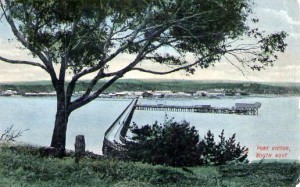
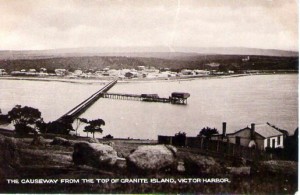
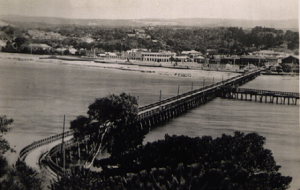
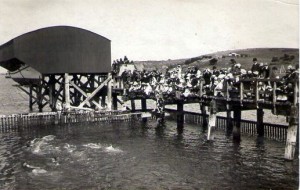
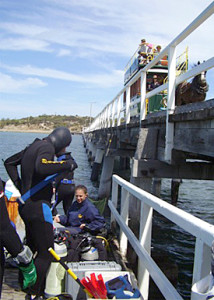
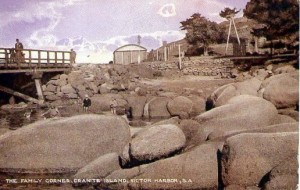

There is a great photo on the Adelaide yesterday and today Facebook page at https://www.facebook.com/AdelaideYesterdayandToday/photos/pb.573501769437836.-2207520000.1441533007./820982891356388/?type=1&theater
i have a great photo of the Public Swimming baths on my Facebook page
Thanks Meron. That photo can be seen at https://www.facebook.com/photo.php?fbid=597993407248049&set=a.114958865551508.1073741827.100011121848916&type=3&theater